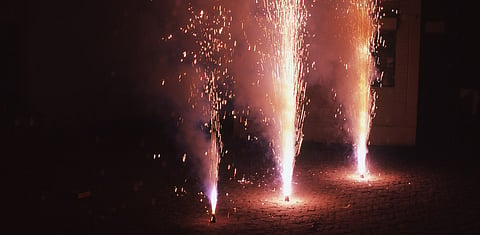

The festivities on Diwali night in 2024 left a heavy mark on the air of India’s capital. Pollution reached apocalyptic levels at midnight in Delhi, an analysis of data shows.
Particulate Matter2.5 (PM2.5) levels had steadily risen in the five days leading up to Diwali, with a marked increase of 46 per cent from October 28 through October 31. By midnight on October 31, PM2.5 hit a peak of 603 microgram per cubic metre (µg/m³)—13 per cent higher than Diwali peaks observed in both 2022 and 2023.
The pollution level was also almost 10 times above the safe 24-hour standard by midnight after Diwali 2024.
While concentrations gradually began to decline after this peak, the morning of November 1 still held onto remnants of the previous night’s pollution, with PM2.5 levels easing to a more moderate 97 µg/m³ by noon.
The average PM2.5 concentration from 6 AM to 4 PM was 92 per cent higher than last year’s Diwali daytime average, despite the normally beneficial effect of atmospheric conditions.
As night fell on November 1, there was a minor reprieve in the levels of PM2.5, which averaged around 386 µg/m³ from 8 PM to 8 AM—8 per cent lower than Diwali night last year. This slight decline hinted at some aid from atmospheric shifts that might have helped disperse pollutants.
The comparison to Diwali 2022—also an October celebration—tells its own story. The 12-hour PM2.5 concentration on Diwali night in 2024 was 34 per cent higher than Diwali night in October 2022, going from 289 µg/m³ to 386 µg/m³. Moreover, PM2.5 levels this year were more than twice as high as the average night-time pollution recorded over the seven nights before Diwali, underscoring how the night’s festivities left a heavy mark on the air.
Across Delhi, this pollution hit with varying intensity. Of 38 air quality monitoring stations, nine recorded PM2.5 levels above the critical threshold of 900 µg/m³. Nehru Nagar led with a critical reading of 994 µg/m³, while Anand Vihar followed closely at 992 µg/m³. Other high readings came from Pusa IMD, Wazirpur, and JLN Stadium, each inching toward the 1,000 µg/m³ mark.
Not only was there particulate matter to worry about; nitrogen dioxide (NO₂) levels told their own troubling tale. For the third year running, NO₂ levels spiked on Diwali night and the nights before, mirroring the traffic congestion typical of festival season. ITO recorded the highest night-time NO₂ average at 182 µg/m³, with other hotspots like JLN Stadium at 104 µg/m³ and Patparganj at 101 µg/m³. By contrast, quieter Lodhi Road saw just 2 µg/m³, underscoring how traffic-driven emissions amplified the city’s air crisis.
Adding to this pollution cocktail, stubble burning in nearby states contributed to Delhi’s elevated PM2.5 levels as fire counts rose significantly just as Diwali arrived. In Punjab, Haryana, and Uttar Pradesh, stubble fires surged from 160 on October 30 to 605 on October 31. Punjab accounted for the largest share of these fires, with 80 per cent, followed by Uttar Pradesh at 13 per cent and Haryana at 7 per cent. North-westerly winds swept the smoke from these farm fires into Delhi on October 31, layering yet another source of pollution into the city’s air.
Though the air seemed clearer by noon on the day after Diwali, because of favourable meteorological conditions, this brief respite is unlikely to last. As atmospheric conditions shift and wind patterns change in the coming days, Delhi is expected to once again find itself enveloped in a dense veil of pollution. This temporary clarity is a reminder of the city’s ongoing struggle with air quality—one that requires more than just favourable winds to overcome. Without deeper, collective action across sectors and states, Delhi’s air will remain a fragile balance, vulnerable to every shift in the season and every spark in the field or street.